overview
Both a symbol and a challenge, choreographing the Rite of Spring is a perilous exercise when one considers the evocative power of the music. But Lionel Hoche is an intelligent creator. He prefered the lighter version, written for two pianos, and has composed a serious though unpretentious work. The world he depicts is a black one, seeped in violence and light. Large lamps hang barely above ground, a stage glazed in green plunges us into a tenebrous atmosphere. The colours are cold, the asymmetrical costumes are black and scintillating, all signs of the disillusionment which reigns on stage.
The dance is precise, biting. Hands move sharply, tearing through the air piercingly while arms bend, reaching out to an imaginary being. Bodies mingle, hasten, propel, clash, connect, untangle, swarm, creating images of order and chaos, of life and death.
The vocabulary is erudite, sophisticated. It builds spaces, with curves and lines, tension, spirals, using the musical score for this. Thus dance and music connect subtly, recalling Baudelaire's poem, Correspondences where "The perfumes, the colours and the sounds respond".
Hoche's Rite of Spring bekons us to a barbarian 20th century ritual, the day-to-day chaos of our lives, battered by reality.
Gallia Valette-Pilenko
translation Adam Vidovic
press
Germany
NURNBERGER ZEITUNG - 19 janvier 2004
"...Lionel Hoche expose de manière plastique et énergique le jeu d'alternance entre attirance et répulsion, la tension entre agressivité et tendresse culmine dans un intense pas de deux entre Dagmar Bock et Ivo Bartsch..."
ABENDZEITUNG -19 janvier 2004
"...Du blues minimaliste aux explosifs mouvements roulés au sol, Hoche réussit de mystérieuses transitions qui révèlent de fascinantes nuances d'atmosphères..."
SERGEI - Mars 2004
"...La sombre et érotique interprétation de Lionel Hoche du Sacre du Printemps entraîne le public dans son sillage. Allez-y..."
NURNBERGER NACHRICHTEN - 12 mars 2004
"...Les scènes d'ensemble séduisent par leur couleur et leur temps : danse-théâtre au meilleur sens du terme..."
FRANKISCHEN TAG - 19 janvier 2004
"...La version piano du Sacre de Stravinsky (interprétée en direct par le duo Andreas Grau/Gosschumacher) souligne, en renonçant à la diversité orchestrale des percussions, l'âpre caractère de l'oeuvre, et offre en combinaison avec la chorégraphie riche de sensualité de Lionel Hoche, une enthousiasmante soirée de danse à Nurenberg..."
The Village Voice (New York)
The Body Speaks
« In the Rite of Spring, the five performers lash and wrap their arms around their own bodies, folding them in. They crook their elbows, cant their torsos, and twitch their shoulders simultaneously, while lifting one hip to swing a stiff leg around to a new stance. They lumber and limp. Being splendid dancers, they make all this look like a fluent language, but its message is still instability, awkwardness, and a kind of protective aggression.
« Hoche uses the two-piano version of Stravinsky's great score to create a party in hell. [...] Céline Zordia-a superbly luxurious dancer-is clearly the sacrificial victim, but Hoche fades in and out of Stravinsky's scenario, and when Zordia falls in a burst of red light and doesn't get up, it's almost a surprise. Wearing bedraggled black finery, the dancers brutalize one another as often as they hit on Zordia, and her innocence and strength seem to thrill them. From time to time, they cluster around and nuzzle her. The image is less that of a primal fertility rite than of a girl's unfortunate coming of age in a dank, druggy, feral hangout. »
Deborah Jowitt - 9th - 15th July 2003
The Dance Insider
An Industrial 'Spring' from Lionel Hoche
"Hoche's Rite of Spring matched Stravinsky's riotous score with a ferocious vigor. While the well-known narrative thread of this notorious work might have hindered a less rigorous choreographer, it's a perfect match for Hoche. The maiden, Celine Zordia, wandered through a forest of industrial, fluorescent lanterns before being joined by Marielle Girard and Loren Palmer in a dance that resembles a highly aggressive girl school hazing. Emmanuel Le Floch and Cedric Lequileuc oozed sleeze in a predatory approach to the women, who willingly participate in sacrificing one of their flock. Hoche manages to capture primal images of male and female, stalker and prey in violent, frenetic masses of movement.
"The costumes, variations of glittering black and red, and Philippe Favier's set of lanterns place the work in a seedy warehouse-cum-disco, and the ancient ritual as taking place last Saturday night. The dance incited such a formidable visceral response to its crescendos of relentless, brutal movement that I felt as exhausted and breathless as the collapsed maiden just before the lights bumped to black."
Maura Nguyen Donohue - The Dance Insider (USA) - July 2003
The Berkshire Eagle
Choreographer's work bears watching
This is indeed a serious young choreographer, but he clearly loves his work
"If we were able to warp time and survey Hoche's Rite of Spring juxtaposed against that of the early moderns (including Nijinsky's version for Diaghilev's Ballet Russe de Monte Carlo) Hoche's dance might look just about as awkward as those attempts. Hoche's extreme groundedness, deliberate use of weight and gravity, the amount of time spent sprawled and rolling on the floor, evoke the initial modern's efforts to stand the airishness of ballet on its head. He's almost self-consciously �??unpretty', resorting to ungainliness - hitching straight-kneed, half-toed walks, for example, or limbs �??deformed', curled in and under rather than stretched and defiant of space. And, he is consciously attuned to principles of mechanics and physics-volume, pivots and fulcrums, hinges.
"This is heady dance, constructed, virtually tacked or forged on the dancer's bodies. The physical limitations that dance has overcome through centuries of technical evolution are reinstated by Hoche as defining principles.
"All of this would seem to defeat its accessibility for dance audiences, even when starved for the new, improved and different. Yet Hoche holds us, fascinates. His very belief in what he's doing, his respect for his material may account for it. It's not ego or pretentiousness talking. [...] It's Hoche's attention to detail we love - to all the details, how the body works, how each of his dancer's bodies work, how they work in space, how they work within zones and grids, under lights, with and without colour, adornment, within and outside the music."
Allison Tracy - 28th June 2003
Critical Dance.com
"The black and white sound of Stravinsky's two-piano score for The Rite of Spring complemented the dark, inverted Cathedral-like atmosphere brought to the performance space by the on-stage lighting. The property of seven circular neon lights asymmetrically clustered and suspended to within a foot of floor on cables that disappeared into the rafters exploited the vaulted capacity of the Duke Theatre."
S.E. Arnold - Critical Dance.com (USA) - June 2003
The New York Times
Getting the Most Out of Movement
"Lionel Hoche stood out among the French choreographers in the France Moves 2001 dance festival in New York. Unlike many of his colleagues, he focused more on formal composition and movement exploration than outright theatricality. That thirst for devising new ways of moving was still apparent in [...] The Rite of Spring ... The cool purity the troupe displayed two years ago was replaced by a raw turbulence [...].
"Mr. Hoche has retained a whiff of Stravinsky's scenario, but he identifies a sacrificial victim at the start rather than at the end. This is a modern-dress version with only five dancers. It recalls Sartre's No Exit in its small-scale focus on what people do to themselves and to others.
"One dancer's action sets another's in motion, usually through body contact that transfers energy from one dancer to another: a domino theory of movement. A barelegged outcast from the start, Ms. Zordia uses her admirable stamina to participate in and escape from several ritual games. There are images of abduction and animal-like nuzzling, [...] a great deal of collapsing and tumbling too, along with some choppy gestures."
Anna Kisselgoff - 19th June 2003
Danser
"Lionel Hoche's Rite of Spring uses the version for two pianos and approaches this classic in an intimate way : five dancers, three girls and two boys. This uneven number, this inequality, govern the relationships between the characters, creating dynamics within the group, exacerbating the rapports of force and isolating one of the girls. Chosen one ? Victim ? She is central to these tensions. Lionel Hoche's choreography builds on these rapports of seduction, conflictual relationships, using the forces of attraction and repulsion inherent to the group, in the manner of an initiatory ritual."
Jacky Pailley - Danser - January 2003
La Tribune Le progrès
"...Lionel Hoche obtains strong physical involvement from his dancers as they explore their innermost recesses. Burning with the fire of subterraneous magnetism, colliding with or yielding to deep seated urges, MéMé BaNjO translates the psyche's meanderings through an energetic dance that uses group dynamics and the rapports inherent to these. The atmosphere is electric, tameless ..."
Claudie Léger - La Tribune Le progrès - November 2002
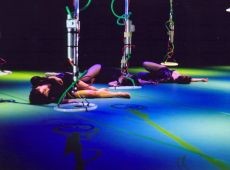
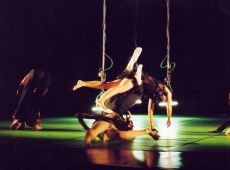
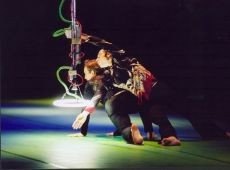
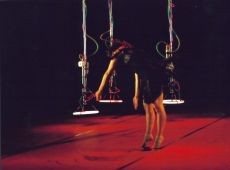
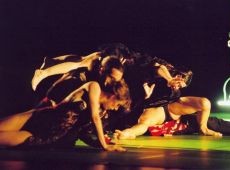
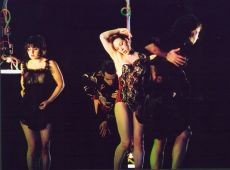
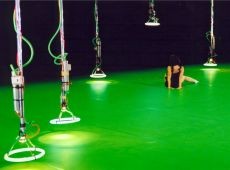
 Dossier artistique
Dossier artistique